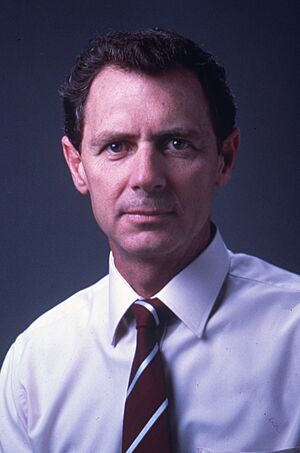Marshall Perron facts for kids
Quick facts for kids
Marshall Perron
|
|
|---|---|
 |
|
| 4th Chief Minister of the Northern Territory | |
| In office 14 July 1988 – 26 May 1995 |
|
| Deputy | Barry Coulter |
| Preceded by | Stephen Hatton |
| Succeeded by | Shane Stone |
| Constituency | Fannie Bay |
| Personal details | |
| Born | 5 February 1942 Perth, Western Australia |
| Political party | Country Liberal Party |
| Spouse | Cherry Perron |
| Cabinet | Perron Ministry |
Marshall Bruce Perron (born 5 February 1942) is a former Australian politician. He was the fourth Chief Minister of the Northern Territory, serving from 1988 to 1995. The Chief Minister is the head of government in the Northern Territory, similar to a state premier.
Perron was a member of the Country Liberal Party (CLP). He served in the Legislative Assembly, which is the territory's parliament, from its beginning in 1974 until he retired in 1995. For most of his time in politics, he was a cabinet minister, helping to lead the government.
Contents
Early Life and Background
Marshall Perron was born in Perth, Western Australia, in 1942. His family was actually from Darwin, but they had to leave their home during World War II. At the time, there was a fear of attacks from Japan.
Perron was born just two weeks before the city of Darwin was bombed. He later joked that this event "denied him his birthright as a Territorian," meaning he wasn't born in the Northern Territory like the rest of his family.
A Career in Politics
| Years | Term | Electoral division | Party | |
|---|---|---|---|---|
| 1974–1977 | 1st | Stuart Park | Country Liberal Party | |
| 1977–1980 | 2nd | Stuart Park | Country Liberal Party | |
| 1980–1983 | 3rd | Stuart Park | Country Liberal Party | |
| 1983–1987 | 4th | Fannie Bay | Country Liberal Party | |
| 1987–1990 | 5th | Fannie Bay | Country Liberal Party | |
| 1990–1994 | 6th | Fannie Bay | Country Liberal Party | |
| 1994–1995 | 7th | Fannie Bay | Country Liberal Party | |
Perron began his political career in 1974. He was elected to the very first Northern Territory Legislative Assembly. He represented the area of Stuart Park for the Country Liberal Party.
Joining the Government
A year after the powerful Cyclone Tracy hit Darwin, Perron was promoted to a leadership role in the government. At this time, the Northern Territory did not have full self-government. Its leaders were called Executive Members. Perron was in charge of important areas like local government, consumer affairs, and education.
After the 1977 election, Perron became the deputy leader of the CLP. When the Northern Territory was granted self-government in 1978, he became the first Deputy Chief Minister. He was also the Treasurer, which meant he was in charge of the government's money.
Changing Roles and a Famous Case
In 1983, Perron was elected to represent a new area called Fannie Bay. In 1984, his job changed again, and he became the Attorney-General. The Attorney-General is the top lawyer for the government.
During his time as Attorney-General, a famous legal case involving Lindy Chamberlain was re-examined. New evidence had been found related to the disappearance of her baby, Azaria, near Ayers Rock (Uluru). Perron announced that Chamberlain should be released from prison and that a special investigation, called a Royal Commission, would look into the case again.
Becoming Chief Minister
On 14 July 1988, Marshall Perron became the Chief Minister of the Northern Territory. He had been offered the job before but had turned it down. As Chief Minister, he also acted as his own Treasurer.
His leadership brought stability to the government, which had seen three different leaders in the four years before him. He remained Chief Minister for almost seven years, making him one of the longest-serving leaders in the Territory's history.
Perron led his party to victory in two elections, in 1990 and 1994.
The Rights of the Terminally Ill Act
Perron was a strong supporter of giving people with incurable diseases the right to make choices about their own lives. In 1995, he introduced a very important bill to the parliament called the Rights of the Terminally Ill Bill.
This bill was designed to give people who were very sick and near the end of their life the legal right to choose to end their suffering peacefully. The bill was passed on 25 May 1995, and it became the Rights of the Terminally Ill Act 1995. This was a world-first law.
On the day the parliament was set to debate the bill, Perron resigned as Chief Minister and retired from politics. He said he did not want his powerful position to influence how other politicians voted. He was the last original member of the first Legislative Assembly to still be serving in parliament.
See also
- Perron Ministry
References
| Political offices | ||
|---|---|---|
| Preceded by Stephen Hatton |
Chief Minister of the Northern Territory 1988–1995 |
Succeeded by Shane Stone |
| Northern Territory Legislative Assembly | ||
| Division created | Member for Stuart Park 1974–1983 |
Division abolished |
| Preceded by Pam O'Neil |
Member for Fannie Bay 1983–1995 |
Succeeded by Clare Martin |
| Party political offices
|
||
| Preceded by Stephen Hatton |
Leader of the Country Liberal Party 1988–1995 |
Succeeded by Shane Stone |

